
|
 |
Vought F4U Corsair by Earl Swihnart |
 |
 |
 |
 |
 |
|---|---|---|---|---|---|---|---|
 |
 |
 |
 |
 |
|||
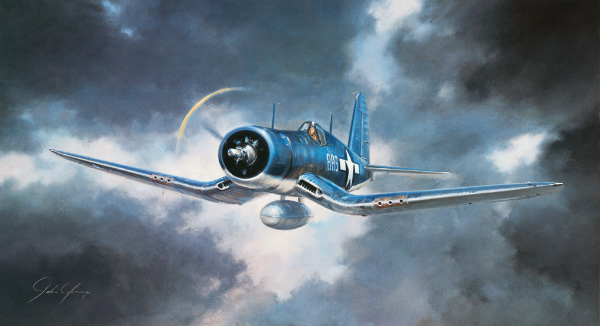 |
||
|
The Corsair's distinctive sound, which earned it among the Japanese the nick-name of "Whistling Death", partly because of the engine sound, that was caused by the wing-root inlets for engine air. Shown above is Maj. Gregory
Boyington's F4U from VMF-214. (Image used with permission from Dare to Move.) | ||
|
If you’ve never seen a Corsair before, your first glance at the outsized
propeller and "bent" wings might leave you with the feeling that either
this warbird was assembled from parts that didn’t match or it has met
with some sort of disaster. But from all these outsized and mismatched
parts came one of WWII’s greatest fighter planes. It could outfight,
outclimb and (if need be) outrun any prop driven enemy.
The US Navy Bureau of Aeronautics had a long tradition of issuing proposals for aircraft which pushed the limits of available technology. This stimulated the manufacturers ability to respond with new technology to meet the challenge. When "BuAer" sent its proposal for a high performance, carrier based fighter to United Aircraft Corporation (parent company of Vought-Sikorsky) on February 1, 1938, it seemed the Navy might have pushed technology to the point of giving it a hernia. C. J. McCarthy, who was Vought’s General Manager, called in the company’s chief engineer, Rex Beisel. Rex was one of those people who lived by the old motto "The difficult we do immediately. The impossible will take a week, ten days at the most." An elite team was selected for the development of Vought Design #V-166; Frank Albright as project engineer; Paul Baker as aerodynamics engineer; James Shoemaker as propulsion engineer. Each had an assistant. These engineers submitted their work to Beisel who then integrated it all into a final design. |
| Early on, Shoemaker chose the Pratt-Whitney R-1830 Wasp air-cooled radial engine because of it’s long history of reliability, and the V-166-A was designed around this engine. But, in 1940, the BuAer’s quest for speed resulted in a switch to the experimental XR-2800-4 version of the Pratt-Whitney Double Wasp, with a two-stage supercharger for the prototype XF4U-1 Corsair. The R-2800 engine was the most powerful engine in the world in 1940, exceeding 100 hp (74.6 kW) per cylinder for each of its 18 cylinders. The change in engines resulted in the design number being changed to Vought Design #V-166-B. The V-166-A was never built. |
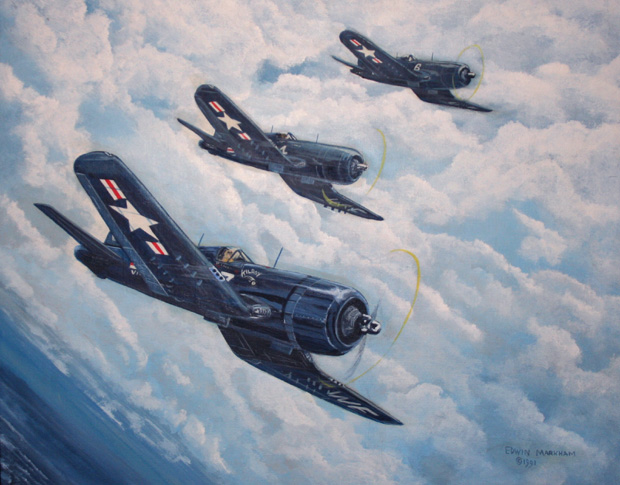
|
| With the awesome 2,804 cubic inch (46 liter) Double Wasp air-cooled radial engine developing 1,850 hp (1,380.6 kW), the only way to convert that kind of horsepower efficiently into thrust was with a huge Hamilton Standard Hydromatic, 3 blade prop which measured 13 feet 4 inches (4.06 meters) in diameter. And that created a problem of deck clearance for the prop. It seemed either the main landing gear had to be lengthened, or the prop had to be shortened. |
| Since the landing gear had to be very strong to withstand the pounding of a carrier deck landing, a short, stout leg was required. Also, there wouldn’t be enough room in the wing to properly stow a longer gear. And, if the prop were shortened, much of the horsepower of the Double Wasp would be wasted. So, Vought engineers came up with the distinctive inverted gull-wing design which forever characterized the F4U Corsair. This "bent wing" design allowed the huge prop to clear the deck while providing for a short, stout landing gear. And, as a byproduct, the wing also improved the aerodynamics of the intersection where the wing attaches to the fuselage, boosting the top speed. |
| It was a very "slick" looking plane using flush riveting and a new technique developed jointly by Vought and the Naval Aircraft Factory called "spot-welding". In order to make the Corsair as aerodynamically clean as possible, there was nothing protruding into the air stream. The intake for the turbo-supercharger, intercooler and the oil cooler were located in slots in the inboard leading edges of the wings. Vought designed the fuselage with a circular cross-section which fit snugly over the Pratt-Whitney engine. The F4U was the first Navy craft to have landing gear which retracted flush into the bottom of the wing, though it took some effort. Other craft had retracting gear, but there was always some bulge or part of the wheel exposed. Vought engineers designed the Corsairs wheels to swivel 90º and retract straight back to fit flat inside the bottom of the wing. The swivel gear was a Boeing development that was also used in the Boeing Monomail, Curtiss P-36 and P-40.1 Two panels then closed over the gear making a perfectly smooth fairing. The idea was to mate the most powerful engine with the smallest, cleanest possible airframe. |
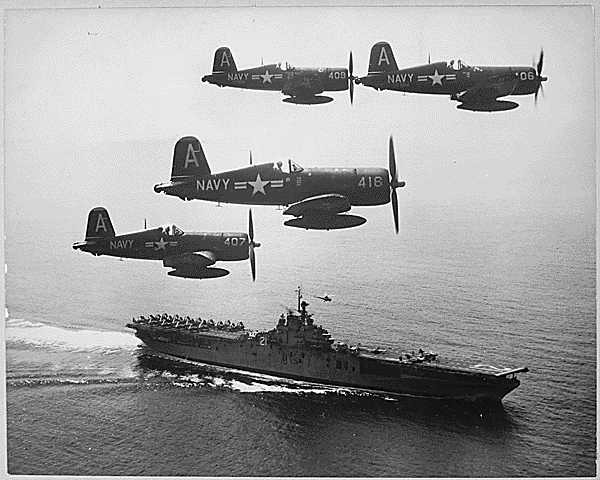
|
|
F4U's (Corsairs) returning from a combat mission over North Korea circle the USS Boxer as they wait for planes in the next strike to be launched from her flight deck. A helicopter hovers above the ship. |
|
The XF4U-1 first went aloft on May 1, 1940 and five months later flew
the 45 miles (73 km) between Stratford and Hartford, Connecticut at a
speed of 405 miles per hour (651.8 kph), becoming the first production
aircraft to exceed 400 mph in level flight.
The US Navy was very pleased with the performance of the Corsair and, in
June 1941, ordered 584 copies. Over the next 11 years that figure would
grow to over 12,500 F4Us.
Several stumbling blocks developed when carrier trials were held aboard the USS Sangamon and other carriers in late 1941. The biggest problem was the long nose. It stuck out 14 feet (4.27 m) in front of the pilot, and when the Corsair was sitting in take-off position, the nose pointed up at an angle sufficient to block forward vision to about 12º above the horizon. In carrier landings it was practically impossible to see the Landing Signals Officer, once the Corsair was lined up with the carrier deck on final approach. Adding to this problem were oil and hydraulic leaks from the engine compartment which seeped past the cowl flaps and smeared the windshield, further restricting visibility. Landing on a carrier deck required the pilot to have the plane at stall speed just as the tail-hook snagged the deck wire, but this was made very difficult by the wicked stall characteristics of the F4U. Just as stall speed was reached, the left wing tended to drop like a rock. In a deck landing this could cause the landing gear to collapse resulting in injuries to the pilot and severe damage to the aircraft. Assuming luck was with the pilot and he landed intact, the Corsair normally "bottomed out" the shock absorbers as it slammed down on the deck. The resulting recoil caused the plane to bounce high in the air. The tailhook itself sometimes failed to "trap" the plane by engaging an arrestor wire. If this happened on a straight deck carrier it usually meant the aircraft plowed into the planes parked forward. (Angle decks did not start appearing on US carriers until 1952.) It was said on a straight deck carrier there were only two kinds of landings; a "trap" and a catastrophe! As the Corsair was thought by the Navy to be unsuitable for carrier duty, it was given to the US Marines for land-based operations where it earned an outstanding combat record. Britain, France, New Zealand, Australia also received the F4U during WWII. |
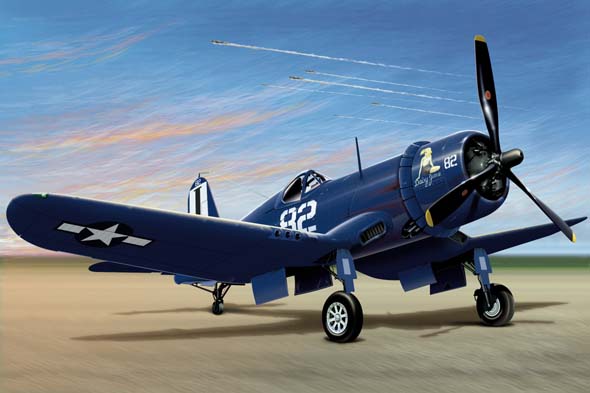
|
|
Shown above is a F4U Corsair from US Marines VMF-511, USS Block Island. |
|
It was the British who finally worked out a method of landing the
Corsair on their carriers in spite of the visibility problems caused by
the long nose. Instead of the normal downwind-crosswind-final approach
method, the British simply turned downwind, then made a slow, continuous
curve which aligned the Corsair with the deck only at the last second
before the aircraft touched down and trapped. This method allowed the
pilot to keep the Landing Signals Officer in view right up to the moment
the plane was over the fan-tail where the LSO gave the sign to either
"cut" or make another attempt.
To alleviate the problem of oil and hydraulic fluid smearing the windshield, the Brits simply wired shut the cowl flaps across the top of the engine compartment, diverting the oil and hydraulic fluid around the sides of the fuselage. Numerous other simple, effective alterations were devised to alleviate the dreadful stall characteristics, landing bounce and tailhook problems (among others), and these modifications were incorporated into the production line. In 1944 the US Navy decided to again try landing the F4U on carriers, and this time succeeded. It turned out to be an extremely wise decision. As the nature of the war changed, the Corsair also changed. There were seven different dash numbers, some built exclusively for foreign countries (the F4U-7 for the French Aeronavale), and one was never built at all (the F4U-6). Some dash numbers had letter suffixes designating different changes in the airframe, weapons or engine. In addition to Vought, the Corsair was built by the Goodyear Aircraft Company, with a lesser production run by Brewster Aeronautical Corporation. |
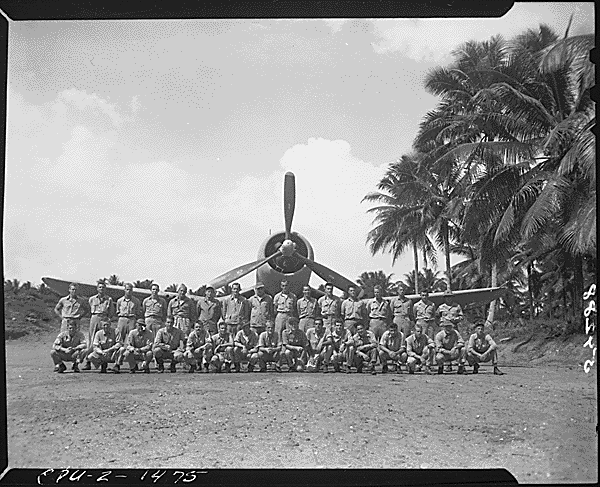
|
|
VMF-214 on Turtle Bay fighter strip, Espiritu Santo, New Hebrides. VMF-214 poses for a group picture before leaving for Munda. Colonel Gregory Boyington's Black Sheep Squadron. |
|
There were also night fighter versions (designated by the suffix letter
"N"), and photo versions (with the suffix "P").
The Corsair underwent over 950 major engineering changes over is
lifetime though none changed the distinctive profile of the F4U. Most
often, production aircraft were simply pulled off the assembly line and
used as test beds. Some of these were designated prototypes with the
prefix "X" (such as the "XF4U-3"). By the end of Corsair production in
1952, there were 16 separate models on the books.
Depending on which Air Squadron you were in, the F4U had many nicknames: "Hose Nose", "Bent Wing Bird", "Hog" and "Ensign Eliminator", the latter due to it’s stall and landing characteristics. Under the right circumstances, the wing mounted air intakes caused a pronounced whistling sound. For that reason, Japanese ground troops called it "Whistling Death". Several varieties of the Pratt-Whitney R-2800 Double Wasp radial engine were used in the Corsair. Some used a water-methanol injection to increase the power for short sprints. This was called "War Emergency" power and had a suffix "W" after the dash number of the engine. During the Korean War, there were modifications to cope with the extreme cold encountered in that theater. These were designated with the suffix "L" (for "Low" [temp]). |
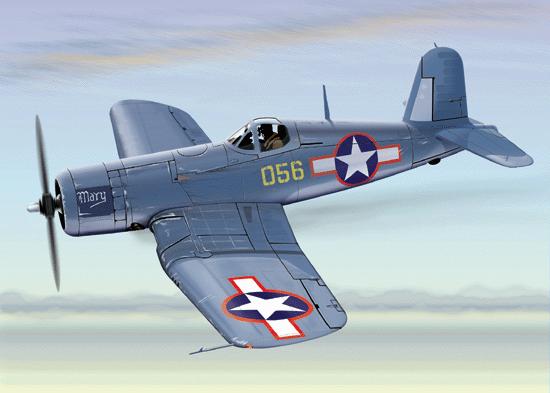
|
|
USMC, VMF-121. Aircraft were used in an in-flight test at Eglin Field, Florida on June 18, 1943 to verify the increased visibility of the proposed design. As per the June 28, 1943 directive, a second major WWII design change was adopted. A white rectangle or bar was added on each side of the blue circle and a red border surrounding the entire insigne. While the new design was estimated to be 60 percent more recognizable, the use of the red border was short lived. The final WWII national insigne was adopted on August 14, 1943, this change eliminated red from the national insigne until after WWII. The red border was replaced with one of blue.2 |
|
The XF4U-1 was of course the original prototype with a greenhouse type
canopy and the
Pratt-Whitney R-2800-4
radial which delivered 1,850 hp
(1,380.6 kW) for take-off and 1,460 hp (1,089.6 kW) at 21,500 feet
(6,553.2 meters). It had two
Browning .50 caliber (12.7 mm) machine
guns mounted in the nose and each wing held two more for a total of
six. Its top speed was 405 mph (651.77 kph). It weighed in at a
maximum 10,074 pounds (4,569.4 kilograms) and had a range of 1,070 miles
(1,722 km).
The F4U-1 was the first production type. It started rolling off the assembly lines in September 1942. The production "dash one" had some changes made to the canopy for better vision to the rear, though this would continue to be a problem until the advent of the "bulged" canopy introduced in the F4U-1A. The two Browning .50s mounted in the nose of the prototype were removed and all six machine guns were mounted in the wings outside the propeller arc which eliminated the need for synchronization. The dash one also featured the Pratt-Whitney R-2800-8 engine. Some were produced with "-8W" engines. Both engines produced 2,000 hp (1,492.5 kW) for take-off, with the water injected -8W producing an extra 250 hp (186.6 kW) for war emergency. Suffix letters for the dash one Corsair ran from "A" to "D" and the "P" photo model. |
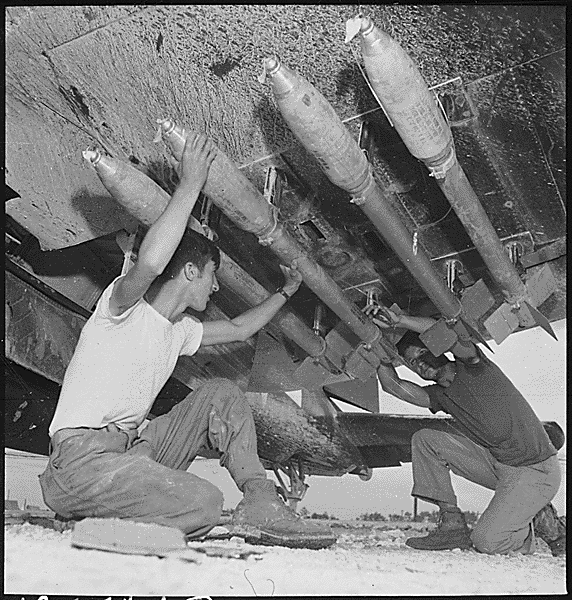
|
|
Five-inch rockets being loaded under the wing of an F4U of MAG-33. Just before take-offs, the safety pins are removed and the rockets are armed. Okinawa, Japan. |
|
F4U-2 was a night fighter version of the dash one. For reasons known
only to the US Navy, instead of calling it the "F4U-1N" (a method it
used on all succeeding models), they gave it the dash two designation.
The dash one was transformed into the dash two by modifying the
starboard wing and the radio bay in the fuselage to accept the "XAIA"
("Experimental Airborne Intercept [model] A") radar which was
hand-built.
The starboard wing was modified by removing the outboard Browning .50 cal. and altering the wing to support the radar scanner. The radio was removed and placed beneath the pilot’s seat and the radar set was placed in the radio bay. There were other slight modifications such as bore sighting the guns to converge fire at 250 yards (228.6 m) and were angled slightly upward so the pilot could fire without bouncing around in the target’s slip-stream. There were no tracers loaded so as not to blind the pilot when firing. The engine was fitted with exhaust flame dampers. After radar installation, the aircraft weighed 235 pounds less than the standard dash one. The F4U-3 was a bump in the evolution of the Corsair. The US Navy had for many months kicked around the idea of a high altitude (40,000+ ft) (12,192+ m) version of the F4U. Toward the latter half of 1943, they approached Vought with the scheme and Vought designer Russell Clark went to work molding the Corsair fuselage around the XR-2800-16 Double Wasp engine which was fitted with two Bierman model 1009A turbo-superchargers. At first the project looked very promising with the engine producing 2,000 hp (1,492.5 kW) at 40,000 ft (12,192 m). But defects in the turbo-superchargers caused the project to be dropped after a few copies had been produced and tested. The dash three could be identified by a large intake tube fitted to the belly below the engine. |
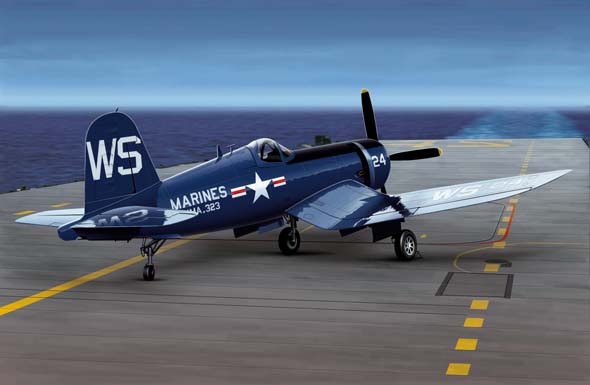
|
|
Shown above is a F4U Corsair from US Marines VMA-323, circa 1952. |
|
The F4U-4 was one of the more important variants of the Corsair. Seven
prototypes were built, anticipating the many problems which would arise
from the proposed changes. Five F4U-1s were pulled from the production
line to be modified into the XF4U-4A, ‘4B, ‘4C, ‘4D and’4E. Two more
"FG-1" aircraft (identical to the Vought F4U-1) were pulled from
Goodyear’s production line. They were all fitted with the Pratt-Whitney
R-2800-18W
engine which produced 2,100 hp (1,567 kW) and sported a new
four blade prop. The engine also had methanol-water injection which
boosted the war emergency power rating to 2,450 hp (1,828 kW) for about
five minutes. The 18W engine necessitated changes in the basic
airframe to handle the extra power and the turbo air intake was mounted
on the inside bottom of the engine cowling (it was called a "chin
scoop") while air for the intercooler and oil cooler continued to be
drawn from the wing slots. The F4U-4 was clocked at a top speed of 446
mph (717.75 kph) at 26,200 ft (7,985.76 m).
Although it wasn’t designated by the Navy as such, the dash four was a fighter-bomber for all intents and purposes. It had 6 Colt-Browning .50 caliber wing mounted machine guns (the F4U-4C substituted four 20 mm cannon), plus it could carry two 1,000 lb (453.6 kg) bombs or eight 5 inch (127 mm) rockets. The first 300 of the production F4U-1Cs were assigned to Marine Air Group 31 and were taken into the Battle for Okinawa aboard the escort carriers Sitko Bay and Bereton. The Army and Marine riflemen who fought that battle on the ground remember the F4U-4 as the "Sweetheart of Okinawa" and it undoubtedly saved many hundreds of their lives. The prototype "Dash Five" was flown in December 1945, a few months after World War Two had ended. It utilized all the knowledge built up over the war years and major changes were made to upgrade the F4U-5 Corsair. First, the engine was changed to the Pratt-Whitney R-2800-32W. This was called a "Series E" engine and featured a dual supercharger to boost engine power to 2,350 hp (1,753.7 kW) at 26,200 ft (7,985.8 m). War emergency power was boosted to 2,760 hp (2,059.7 kW). The dual supercharger necessitated removing the chin scoop and installing two "cheek" scoops inside the engine cowling. Due to the higher horsepower, the fuselage was lengthened by 5 inches (127 mm) and the engine angled down about 2º to provide more stability. Until the dash 5, the outer top wing panels and the control surfaces of the Corsair had been fabric covered. At speed, the fabric tended to deform and slow the aircraft by a few miles per hour. The F4U-5 had all fabric surfaces replaced with sheet duralumin to minimize this problem. Armament was the same as the F4U-4. |
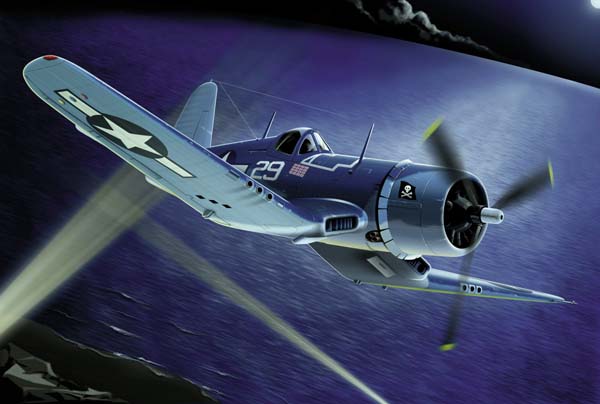
|
|
Shown above is the F4U Corsair of Lt. J.G. Ira Kepford from US Navy VF-17, circa 1944. |
|
A few improvements were made solely for pilot comfort. Cockpit heating
was redesigned, controls were made easier to operate and/or automatic.
Armrests were installed on the seat, which reclined slightly.
With the improvements and the -32W engine, the dash five could operate
very comfortably at altitudes approaching 45,000 feet (13,716 meters).
The AU-1 project began life as the F4U-6 but was quickly redesignated by the Navy to reflect its ground attack role. The dash six was never built. The AU-1 was produced solely for the US Marines during the height of the Korean War. Deliveries began in January 1952 and a total of 111 were supplied during the year. The AU-1 was powered by an R-2800-83W Double Wasp with a single stage supercharger, developing 2,300 hp (1,716.4 kW) for take off and 2,800 hp (2,089.6 kW) for War Emergency. Extra armor was added for protection from the small arms fire which would be encountered at the lower altitudes where the AU-1 would be working. It’s ground attack role was underlined by the statistics; max take-off weight was almost 10 tons (9071.9 kg) while the service ceiling was only 19,500 ft (5,943.6 m) and the maximum speed was a mere 238 mph (383 kph)! Ground attack required only enough speed to present a difficult target for ground fire and only enough altitude to properly aim it‘s weapons. The AU-1 was armed with 10 rockets or 4,000 lbs (1,814.4 kg) of bombs, in addition to four wing mounted 20 mm cannon with 230 rounds per gun. A fully armed AU was an awesome war machine! The F3A-1 was produced by the Brewster Aeronautical Corporation and was identical to the F4U-1. Internal management problems at the corporation caused the Navy to end Brewster production in 1944 after over a year in which only 735 aircraft rolled off the Brewster assembly line. Goodyear produced a number of Corsair models identical to the Vought models. But since it was easier to interrupt Goodyear production than Vought, some experimental models were also constructed. Most notably the F2G series which featured an entirely new engine; the Pratt-Whitney R-4360-4 "Wasp Major". The airframe received significant alterations in order to mount this engine. The Wasp Major could deliver 3,000 hp (2,238.8 kW) for take-off and 2,400 hp (1,791 kW) at 13,500 feet (4,114.8 m). Top speed was 431 at 16,400 ft (4,998.7 m). It was armed with four .50 cal. (12.7 mm) Browning machine guns with 300 rounds per gun, and could carry two 1,600 lb (725.8 kg) bombs on wing pylons. The F2G-1 was the land based version, while the F2G-2 was the carrier model. Although hundreds were on order by August 1945, only 5 examples of each were built due to cancellations at the end of hostilities. All ten of these were sold as surplus, and a few could be found at various air races around the country after the war. The entire production run of the F4U-7 was tailored specifically for the French Navy (the "Aeronavale"). Ninety-four copies were built and all were sold to the Aeronavale. The dash seven was an upgrade of the AU-1 built specially for ground attack. Production of the dash seven began in June, 1952 and when the last one was delivered to the French in December of that year, the long production run of the Vought F4U Corsair came to an end. |
| Specifications: | |
|---|---|
| Vought F4U-4 Corsair | |
| Dimensions: | |
| Wing span: | 41 ft (12.5 m) |
| Length: | 33 ft 8 in (10.3 m) |
| Height: | 16 ft 1 in (4.90 m) |
| Wing Area: | 314 sq ft (29.17 sq m) |
| Weights: | |
| Empty: | 9,205 lb (4,175.3 kg) |
| Gross: | 12,420 lb (5,633.6 kg) |
| Maximum Take-Off: | 14,670 (6,654.2 kg) |
| Performance: | |
| Maximum Speed: | 446 mph (717.75 kph) @ 26,200 ft (7,985.8 m) |
| Cruise Speed: | 000 mph (000 km/h) |
| Service Ceiling: | 41,500 ft (12,649.2 m) |
| Normal Range: | 0,000 miles (0,000 km) |
| Maximum Range: | 1,560 mi (2,510.5 km) |
| Powerplant: | |
|
One Pratt-Whitney R-2800-18W Double Wasp
eighteen-cylinder radial engine, developing 2,100 hp (1,567 kW) for take-off, 1,950 hp (1,455 kW) @ 23,300 ft (7,101.8 m), 2,450 hp (1,828.4 kW) for "War Emergency". | |
| Armament: | |
| Six Colt-Browning M2 .50 caliber (12.7 mm) machine guns (some variants had four 20mm cannon) and two 1,000 lb (453.6 kg) bombs or eight 5 in (127 mm) rockets. | |
|
When the Korean conflict began, VMF(N)513 was sent from MCAS (Marine Corps Air Station) El Toro with twelve F4U5(N)s to Atsugi, Japan. They flew night interdiction missions from Atsugi until southern South Korea was cleared. VMF(N)513 then moved to K-1 airfield near Pusan. By that time the 38th parallel was secured as a front. VMF(N)513 then covered three roads coming from North Korea during night hours. A navy PB4Y2 flew from Japan and dropped flares over these roads so that the F4Us could work underneath, attacking trucks, tanks, trains, and troop movements. The F4U5(N)s were equipped with 20mm cannons in the wings, four bomb/rocket racks under each wing. Additionally they could carry, one drop fuel tank and two napalm tanks. A radar dome was mounted in the right wing. Radar was extremely useful in these operations. These flights were very effective in slowing down traffic to the front lines. Additional duties included night time scramble alerts at K-14 (Kyongsong) to meet aircraft intrusions from the North. There were some "In Close" air support flights to the front line units. A few planes were equipped with special equipment for MPQ flights during day light hours. In late 1950, VMF(N)542 transferred twelve Grumman F7Fs Tigercats to VMF(N)513 which then gave the squadron twelve F4Us and twelve F7Fs. In late 1951, VMF(N)513 moved to K-6 (P'Yong'taek) and remained there until Douglas F3D Skynights replaced all the F4Us and the F7Fs to the end of the conflict. "WF" were the letters painted on the vertical stabilizers. I Raymond M. Smith Major, USMC retired, flew the F4U-4B and the F4U5(N) at MCAS Cherry point NC and MCAS El Toto as well as in Korea with VMF513 during 1950 and 1951. I flew all the different missions mentioned above. Decorations I received in Korea included the Air Medal with three gold stars, and one Distinguished Flying Cross. |
Endnotes:
|
1. Peter M. Bowers. Boeing Aircraft Since 1916. New York: Funk & Wagnalls, 1968. 219. 2. John M. Elliot. The Official Monogram US Navy & Marine Corps Aircraft Color Guide. Sturbridge, Massachusetts: Monogram Aviation Publications, 1989. 70. |
©Earl Swihnart. The Aviation History On-Line Museum.
All rights reserved.
Created September 30, 2000. Updated October 6, 2014.